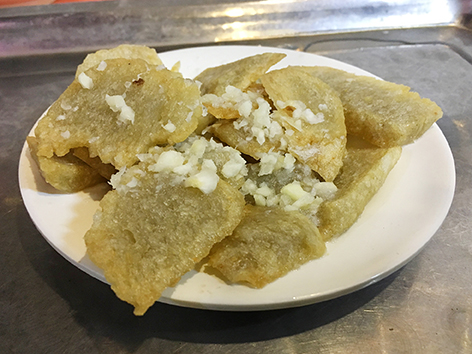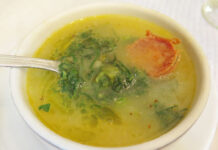What: Ask for guanchang anywhere else in China, and you’ll be given a sausage. Ask for one in Beijing, however, and you’ll end up with a plate of crispy chips of deep-fried batter, with garlic shavings sprinkled on top. There is still something slightly sausagey going on here, though, as beneath that batter are slices of stir-fried intestine. There are two main ways of cooking guanchang, one resulting in an almost translucent gray color, and the other, which adds mashed-up tofu to the batter, lends a golden-brown tint and a flavor that almost completely masks the liver-like taste of the intestine slices within.
Generally off the radar for international travelers, guanchang is very commonly found on the must-eat list of traveling Chinese foodies. In addition to the garlic on top, it’s typically eaten dipped in dark vinegar, giving the whole thing a strong sour taste that might not be to everyone’s liking.
Where: Yao Ji (姚记, 311 Gulou Dong Dajie, 鼓楼东大街311号, map), tucked away in the shadow of Beijing’s iconic Drum Tower, is a good spot for this, though try to avoid the place on weekends, when it’s crammed with local sightseers.
When: Daily, 6am-10pm
Order: A small plate of guanchang, which is the milder tofu variety here, costs 8 RMB. Traditionally eaten as a snack and sold from roadside stalls, today guanchang is typically a side dish. Yao Ji is also well-known for another blood-and-guts dish, its signature liver stew (chao gan, 炒肝). If you’re not willing to go that far, its meat dumplings (rou baozi, 肉包子) are also quite good.
Alternatively: If you’d like to try the other kind of guanchang (minus the tofu), you can find the more “intestiney”-tasting variety by visiting Huguosi Xiaochi (护国寺小吃, 214 Dongsi Bei Dajie 东四北大街214号, map).
There has never been a better time to plan your next trip and make your Dream vacation a reality . Whether you've been dreaming of relaxing on a sun-kissed beach, exploring ancient cities, or embarking on an epic adventure, now is the perfect moment to make it happen.













